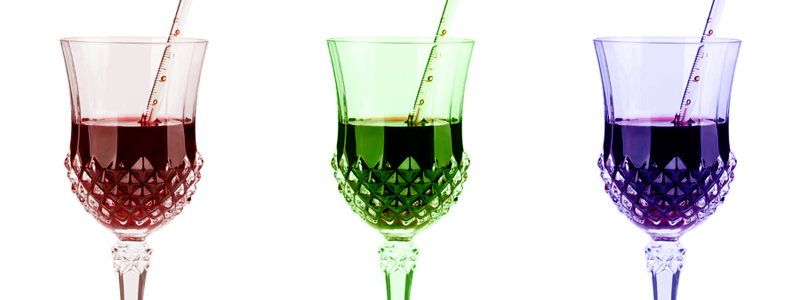Even if you don’t consider yourself a wine aficionado, there are some basic questions you may find yourself asking when it’s time to pop a bottle. Does serving wine at certain temperatures affect how the wine tastes? Are there ideal temperatures at which to serve different types of wine? Are these stupid questions? Yes, yes, and hardly. Better yet, you won’t need a map of Europe or a pricey wine fridge to nail your serving technique, and knowing what wines to serve at what temperatures is much easier than you might think.
To be clear, temperature can, indeed, dramatically impact the way a wine smells and tastes. Cooler serving temperatures can mute the aromatics of a wine and emphasize its structure, making the acidity more apparent, but also pumping up the tannins and bitterness. That’s why wines that are aromatic — like a Sauvignon Blanc, Riesling, or Gamay — can benefit from a chill, since the aromas are strong enough to persist through cold temperatures. But don’t go chilling all your bottles from sunrise on: wines that have more subtle flavor profiles or are more full-bodied can completely lose their character if they’re served too cold. Wines high in tannin — like orange wines made with longer macerations or heavy reds like Cabernet Sauvignon or Aglianico, for example — are best enjoyed at the higher end of the temperature range because chilling them can make them unpleasant and astringent to drink.
While there are some general guidelines for each category, as we’ve listed below, there are a range of styles within these groups, so keep each bottle’s specific characteristics in mind when you pop it in the fridge. Sometimes personal preference can come into play as well, so don’t be afraid to experiment with temperature at home. (While you can play it by touch and taste, a handy-dandy wine thermometer is far more affordable than a wine fridge, and can help you track your ideal serving point.) Starting a bottle off cold and seeing how it evolves as it warms up over time is a great way to find your sweet-spot.
Consider the below your wine temperature serving guide.
Ice Cold (40 to 50 degrees)
Sparkling Wine
We like to put our bubbly in the freezer about an hour before we pop it, but don’t forget about it or the bottle could explode. If you’re short on time, you can also place the bottle in an ice bucket for 30 minutes and have similar results. The ice-cold temperature will keep the bubbles fine rather than foamy. After you open the bottle and pour the first glasses, you should place the open bottle on ice until the entire bottle is finished.
Cold (45 to 55 degrees)
White Wine
For lighter, aromatic, or sweet white wines, it’s typically ideal to serve them cold. The best way to chill white wine is to place it in the fridge immediately after buying it. But if you’re buying the wine the same day you want to drink it, either leave it in the fridge for several hours or place it in the freezer for about 30 minutes. After opening the bottle and pouring everyone their first glass, we prefer not to place it on ice, but instead let the bottle sweat on the table as the wine’s aromas and character changes slightly as the temperature rises. For fuller-bodied white wines, it can be smart to serve them on the higher end of this temperature range, because cooling them down too much can mute their already subtle aromas. Try serving a bold, oaked Chardonnay at 55 degrees to see the difference it can make.
Rosé Wine
Similar to the white wine category, there are a wide range of rosé styles, so the optimal rosé wine temperature can vary from bottle to bottle. If you have a lighter-bodied, Provence-style rosé, for example, those are usually best enjoyed cold. But for some styles like Cerasuolo d’Abruzzo that have a little more body and structure, it’s best to veer on the warmer side of this temperature range.
Chilled (55 to 60 degrees)
Orange Wine
Orange wines can be made with different levels of skin-contact, so there are lighter versions that come across more like white wines as well as bottles made with long macerations that can structurally be more like red wine. If the wine sees only a short period of skin-contact and drinks like a light, aromatic white wine, you can serve it with a bit more of a chill. However, skin-contact wines that have intense tannin and more savory, bitter flavors should only be served slightly chilled or cellar temperature. This will allow more of the nuanced flavors to shine through, and also keep the tannins from feeling overly intense.
Light-Bodied Red Wine
When it comes to how to serve red wine, it really depends on the style it’s made in. Lighter-bodied reds have more aromatics, high acidity, and low tannin. This style can really thrive when served at a cooler temperature than the more heavy reds, so much so that the category has even earned its own title as chillable reds. Grapes like Gamay, Mencia, Trousseau, Frappato, and Schiava tend to have bright, red berry notes, high acid, and low tannin, making them the perfect candidate for a chill.
Cool (60 to 65 degrees)
Medium to Full-Bodied Red Wine
The most common misconception with heavy red wine is that it’s ideal to serve it at room temperature. In fact, serving it slightly cool is the best way to enjoy it. To cool red down to its proper temperature, we like to place it in the fridge an hour before serving it. For quicker results, you can put it in the freezer for just 15 minutes. After opening and either decanting or pouring the first glasses, we like leaving the wine out on the table to slowly warm.
